Ten days after Jesus ascended into heaven (and fifty days after his resurrection), his Holy Spirit descended on the apostles, manifesting as “tongues of fire” (Acts 2:3). This miraculous gift enabled the apostles to speak in languages foreign to them but native to the many Jews from abroad who were gathered in Jerusalem for Shavuot (called “Pentecost” by Hellenized Jews), a festival of giving thanks for the harvest and for God’s provision of the Torah. For the first time the gospel of Jesus Christ was proclaimed to a global audience. Three thousand people came to faith that day, and the Christian church was born.
The Spirit is still at work in the dissemination of the good news today, breathing life into cultures all over the world and thereby building up an incredibly diverse body of Christ.
The arts are one expression of this diversity.
In the introduction to his groundbreaking book Each with His Own Brush: Contemporary Christian Art in Asia and Africa (New York: Friendship Press, 1938), Daniel Johnson Fleming writes,
As at Pentecost, Parthians, Medes and Elamites heard the message, “every man in his own tongue wherein he was born,” so we see Chinese and Japanese and Indians expressing Christianity’s universal language, each with his own brush. For when the spirit of God descends upon any people, new forms of beauty appear, new artistic gifts are revealed, adding another testimony to the universality of the Christian faith.
Since the publication of this book almost seventy years ago, Christianity has grown exponentially in Asia, as have indigenous artistic expressions of the faith. In 1975 Japanese theologian and arts advocate Masao Takenaka published the heavily illustrated book Christian Art in Asia, highlighting the robust variety being produced on the continent. Three years later the Asian Christian Art Association was founded to encourage the exchange of ideas between Asian artists and theologians. Their magazine, Image (not to be confused with the Seattle-based quarterly), has showcased local talents even further. Dozens more books have been published in English on individual Asian artists, countries, and the Asian Christian art movement in general. For the latter, see the beautifully designed The Christian Story: Five Asian Artists Today, plus The Bible Through Asian Eyes.
Below is a sampling of Asian art on the theme of Pentecost. Some works were made using traditional art forms or techniques—Chinese papercutting, Japanese flower arranging (ikebana) or stencil printing (kappazuri), Indian cloth dyeing (batik)—while other artists have chosen to work in oils and acrylics, collage, or glass. Some depict native people and settings—for example, Thai dancers wrapped in sabai, or a group sitting under a thatched roof in Indonesia—while others prefer ethnic and geographic ambiguity. There’s no single style that epitomizes the art of any country.
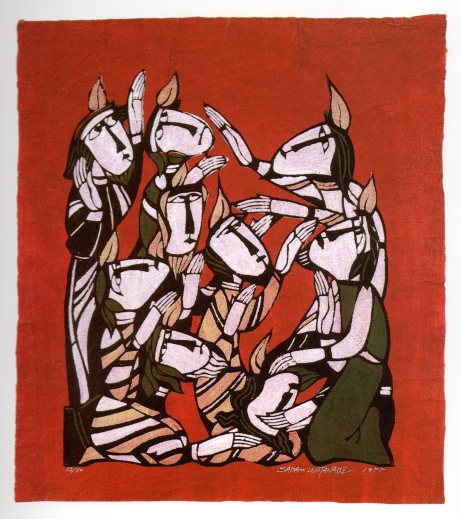




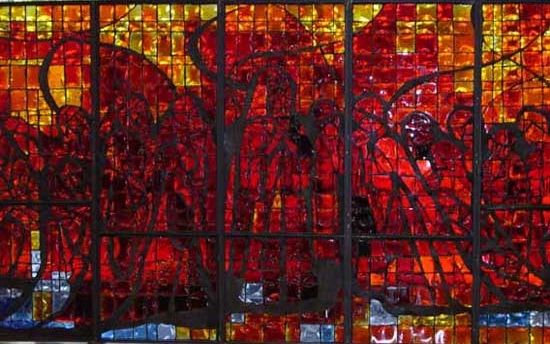




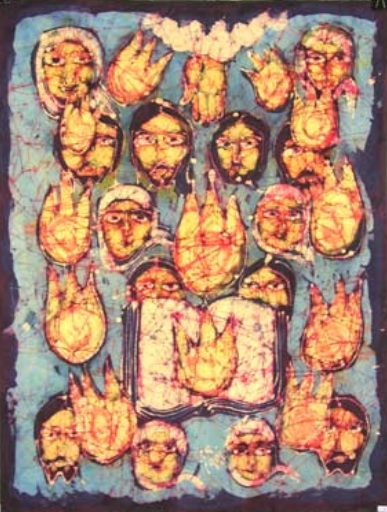

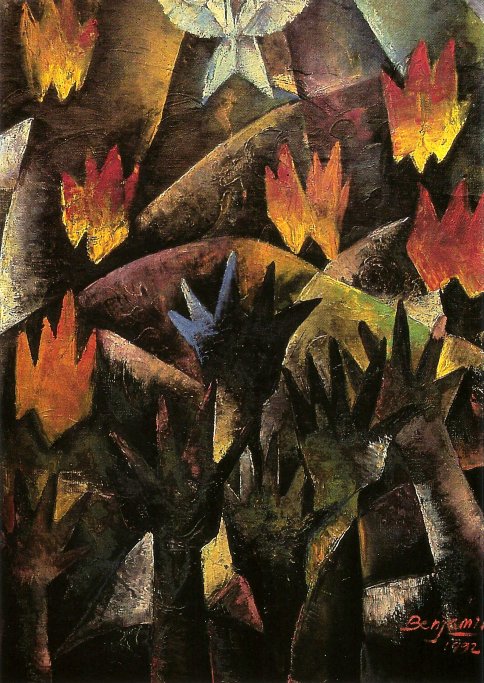
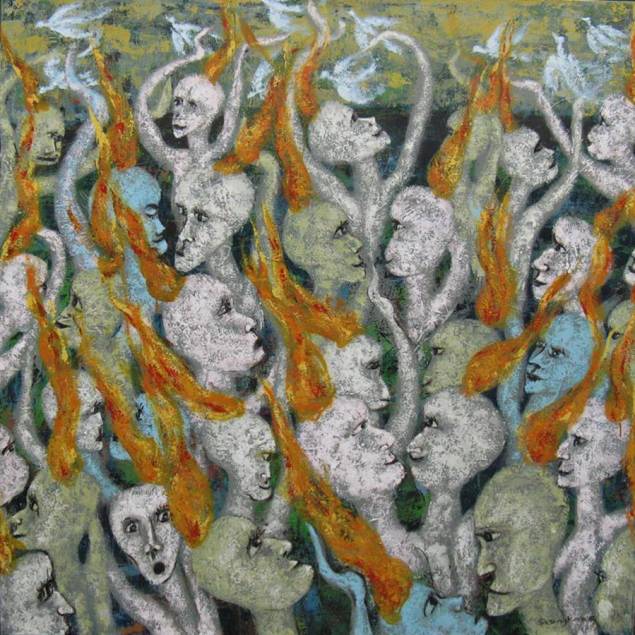
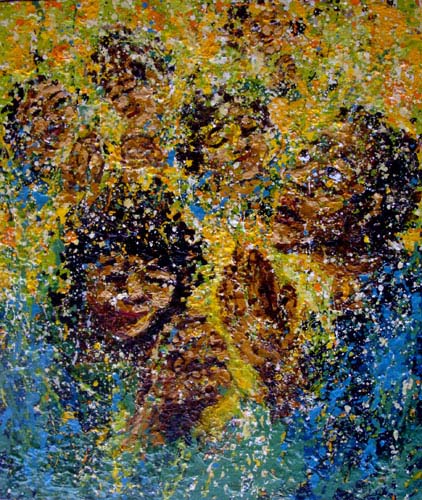

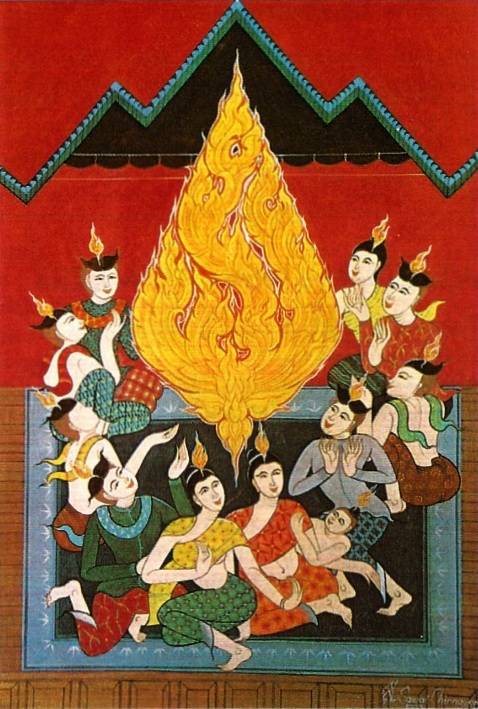
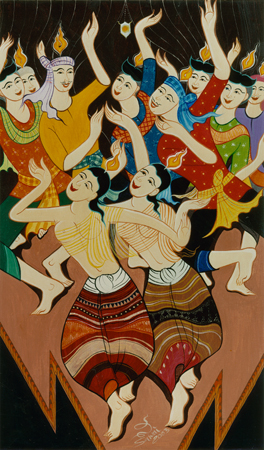
Here are three additional artworks related to Pentecost.

The first one, an untitled painting by Korean artist Kim Young Gil, could be interpreted as a Pentecost image, but it also references the episode in John 20:22, in which a few weeks before Pentecost Jesus breathes on the disciples, telling them, “Receive the Holy Spirit.” Narratively, this episode is a little confusing, because Acts suggests that the Holy Spirit didn’t come until Pentecost. Most theologians believe Jesus’s words and action in this passage to be a pledge of what he would soon be doing at Pentecost—that the Holy Spirit wasn’t actually received at this time but was only promised and symbolized. Others say that the Holy Spirit became present here in a more limited way, much as he had in the lives of earlier prophets. Gil’s painting draws on imagery from both this “pre-Pentecost” and Pentecost itself, as well as from Ezekiel’s vision in the valley of dry bones. The passages are easily conflated because their concept is the same: breath/wind/Spirit as an animating force for the church, for the new creation.

The Great Commission by Sri Lankan artist Nalini Jayasuriya is, as the title indicates, linked to Matthew 28:16–20, in which Jesus gives his disciples an important task, presumably just before his ascension:
Go therefore and make disciples of all nations, baptizing them in the name of the Father and of the Son and of the Holy Spirit, teaching them to observe all that I have commanded you.
And again, an allusion to the Spirit, who empowers us for this task:
And behold, I am with you always, to the end of the age.
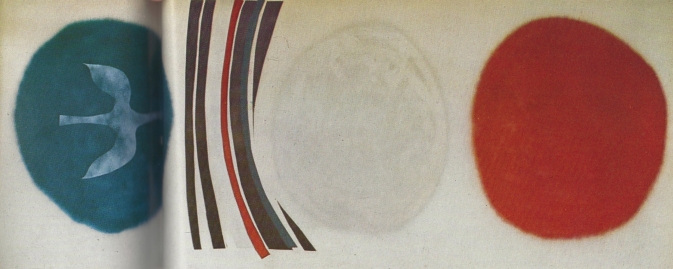
Holy Spirit in Korea by Yoong Bae isn’t necessarily a depiction of Pentecost, but it does depict God’s presence, like a dove, entering the country to stay. The imagery recalls the Spirit of God hovering over the face of the waters at the first creation (Genesis 1:2), suggesting that he’s still in the business of creating.
A big thanks to Paul Neeley over at Global Christian Worship for providing the images by Tadao Tanaka, Jae-Im Kim, Benyamin, and Yoong Bae. (I envy the size of his personal library, and the extent of his travels!) Paul’s blog is a constant source of inspiration for me. Some of his recent posts featuring Asian art include “Resurrection Art (India, Sr. Claire)”; “Holy Week Art from Japan (Ikebana, flower arrangements),” plus a post dedicated to the Pentecost ikebana pictured above; and “Christ the Crucified in India (woodcuts by Solomon Raj).” He has an archive that stretches all the way back to 2011 and that is well worth exploring. Keep an eye out for an upcoming post of his on Pentecost art from India.

Beautiful! Thanks for sharing!
LikeLike
Gorgeous selections. Thank you so much for pulling them together. Such marvelous examples of appropriate contexualization.
LikeLike
So beautiful! Thanks for sharing! I will most certainly reblog it at Pentecost! Right now, my mind and heart are still in Pascha! Christ is Risen!
LikeLike
I will be showing some of these images in my bible study tonight. We are studying Acts 1:1 to 2:13 tonight, and these are great examples (in terms of content, form and artist) of the universality of the gospel, one of the themes we’ll be looking at.
I love your blog – thank you for doing this!
LikeLike
[…] (Related post: “Pentecost art from Asia”) […]
LikeLike
[…] View additional Pentecost artworks from Asia, by Raj and others, at https://artandtheology.org/2016/05/15/pentecost-art-from-asia/. […]
LikeLike
Are these images copyright-free? What kind of permissions are needed to use them for online worship?
LikeLike
They are not copyright-free, and I have posted them here with the presumption of “fair use,” with citations of (or links to, where possible) their source. Some of these artists are deceased, so their estate or an organization likely owns the copyright in those cases. Otherwise I’d recommend getting in touch with the artists themselves. I have email addresses for Jyoti Sahi, He Qi (who has a licensing policy set up for churches), and Soichi Watanabe, which I’ll send you.
LikeLike
Thank you for this. Could you provide me with contact information for He Qi to see if our church can show the art piece on our church website?
LikeLike
You’re welcome. You can find He Qi’s email address on his website: https://www.heqiart.com/contact-he-qi.html.
LikeLike
[…] Pentecost Art from Asia https://artandtheology.org/2016/05/15/pentecost-art-from-asia/ […]
LikeLike
[…] https://artandtheology.org/2016/05/15/pentecost-art-from-asia/ […]
LikeLike
[…] Twenty-one artworks from Asia depicting the descent of the Holy Spirit from Acts 2 […]
LikeLike